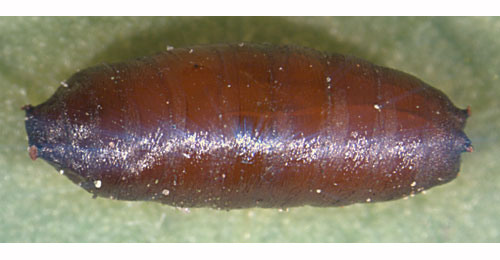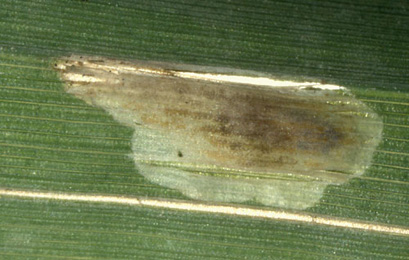|
||||||
|
POLYGONUM. Knotgrasses. [Polygonaceae] |
|
Six species of Polygonum are recorded as native to Britain - Equal-leaved Knotgrass (P. arenastrum), Knotgrass (P. aviculare), Northern Knotgrass (P. boreale), Sea Knotgrass (P. maritimum), Ray's Knotgrass (P. oxyspermum) and Cornfield Knotgrass (P. rurivagum). A further two species have been introduced - Lesser Red-knotgrass (P. arenarium) and Red-knotgrass (P. patulum). The BSBI provide a downloadable plant crib for Polygonum aviculare agg. Sea Knotgrass (P. maritimum) is protected under Schedule 8 of the Wildlife and Countryside Act, 1981. Six British miners are recorded on Polygonum. A key to the European miners recorded on Polygonum is provided in Bladmineerders van Europa. |
Key for the identification of the known mines of British |
1# > Tunneler: The larvae of a number of species of Chironomidae (non-biting midges) live in tunnels in decaying leaf sheaths under water. Their tunnels are open at both ends, and the larvae feed on particles they obtain from a water current they create in the tunnels. They do not feed on tissues of their 'hostplant' and therefore are not strictly miners. |
|
| Cricotopus trifasciatus (Meigen, 1813) [Diptera: Chironomidae]. |
1a > Leaf-miner: Blotch mines, generally occupying an entire leaf, usually containing several larvae. Much, half deliquescent, green frass The record on Polygonum requires confirmation. |
|
Pegomya betae (Curtis, 1847) [Diptera: Anthomyiidae]. |
1b > Leaf-miner: Large upper side blotch or blister mine, which can start with a short corridor. In small leaves the mine can be full depth in places. Often several larvae in a mine; frass irregularly scattered in large lumps. Pupation external. The mine is illustrated in British Leafminers. Large blotch, theoretically upper-surface, but often virtually full depth, often preceded by a short, broad corridor. Usually several larvae in a mine. The larvae can leave their mine and make a new one elsewhere. At the start of the first mine a small group of oval, whitish, egg shells. Pupation outside the mine. |
|
Pegomya bicolor (Wiedemann, 1817) [Diptera: Anthomyiidae]. |
1c > Leaf-miner: Linear mine, becoming a blotch. Two or more larvae feeding together. Frass in lines. |
 Pegomya solennis puparium Image: © Willem Ellis (Bladmineerders van Europa) |
|
Pegomya solennis (Meigen, 1826) [Diptera: Anthomyiidae]. |
1d > Leaf-miner: Irregular mine, locally shallow, elsewhere much deeper, giving it a mottled appearance. In broadleaved plants the mine often begins as a blotch with stellate extensions, but sometimes as a very fine, shallow corridor. In grasses the mine often begins in the leaf sheath. The frass is very fine-grained, initially scattered, later in aggregates. The egg is deposited on the plant surface, and the empty egg shell remains visible. But the larvae are able to leave their mine and restart elsewhere, thus mines without an egg shell can be found as well. The larva also leaves the mine before pupation. Pupation takes place in a newly made, small, blotch mine without frass; this mine may be made in another plant (species). |
|
|
Hydrellia griseola (Fallén, 1813) [Diptera: Ephydridae]. |
1e > Leaf-miner: Initially a gallery is formed, this turning into a blotch, and later two successive conical leaf-rolls. Initially a pale, later brown, usually lower-surface blotch. The blotch is preceded by an epidermal corridor, but that may be obliterated by the later blotch. Silk at the inside of the mine causes it to buckle up a bit and fold. The reddish brown frass is accumulated in a corner of the mine. The older larva leaves the mine and continues feeding inside an untidy cone, made by cutting off a strip of leaf tissue and stitching it in place with silk. |
|
Calybites phasianipennella (Hübner, 1813) [Lepidoptera: Gracillariidae]. |
| Last updated 06-Jul-2019 Brian Pitkin | ||

